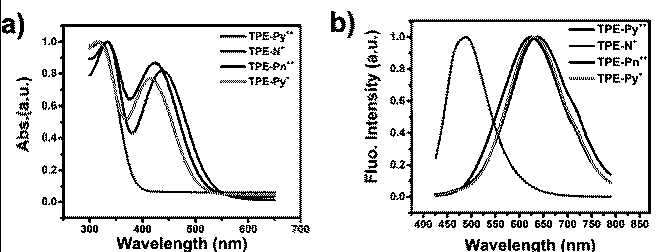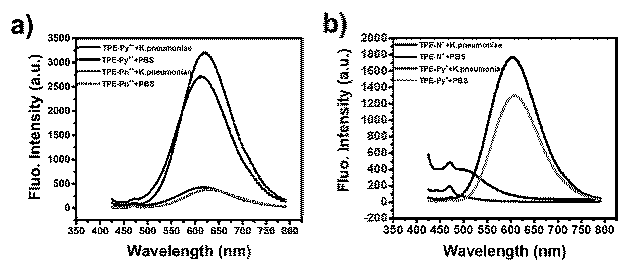Method for selectively imaging capsular bacteria by using tetraphenyl ethylene derivatives
A tetraphenylethylene, selective technology, applied in biochemical equipment and methods, microbial measurement/inspection, fluorescence/phosphorescence, etc., can solve problems such as difficult to stain thick capsular bacteria, achieve excellent water solubility, good light The effect of stability and strong membrane penetration ability
- Summary
- Abstract
- Description
- Claims
- Application Information
AI Technical Summary
Problems solved by technology
Method used
Image
Examples
Embodiment
[0032] Example: Synthesized tetrastyryl compounds with aggregation-induced luminescent properties
[0033] Structural formula:
[0034]
[0035] Synthesis process see figure 1 The synthetic route shown.
[0036] (1) Synthesis of TPE-Py +: First, the reactants 1,2-lutidine-1-iodide (55.95mg, 0.24mmol) and TPE-CHO (50mg, 0.12mmol) were dissolved in absolute ethanol (30mL) and a few drops of triethyl amine. Then the reaction mixture was heated under N 2 Reflux for 48 hours under protection. After the reaction mixture was cooled to room temperature, the mixture was dissolved in water and CH 2 Cl 2 Extract three times. Then add Na 2 SO 4 dry. The crude product was purified by silica gel column using CH 2 Cl 2 / MeOH mixture (10: 1 v / v) as eluent to give a yellow powder (23.50 mg, yield: 31%). 1 H NMR (500MHz, Chloroform-d) δ9.32(d, J=6.2Hz, 1H), 8.34(t, J=8.0Hz, 1H), 8.25(d, J=8.4Hz, 1H), 7.80(t ,J=6.9Hz,1H), 7.59(d,J=15.7Hz,1H),7.49(d,J=7.9Hz,2H),7.34(s,1H),7.14(q...
PUM
 Login to View More
Login to View More Abstract
Description
Claims
Application Information
 Login to View More
Login to View More - R&D
- Intellectual Property
- Life Sciences
- Materials
- Tech Scout
- Unparalleled Data Quality
- Higher Quality Content
- 60% Fewer Hallucinations
Browse by: Latest US Patents, China's latest patents, Technical Efficacy Thesaurus, Application Domain, Technology Topic, Popular Technical Reports.
© 2025 PatSnap. All rights reserved.Legal|Privacy policy|Modern Slavery Act Transparency Statement|Sitemap|About US| Contact US: help@patsnap.com



